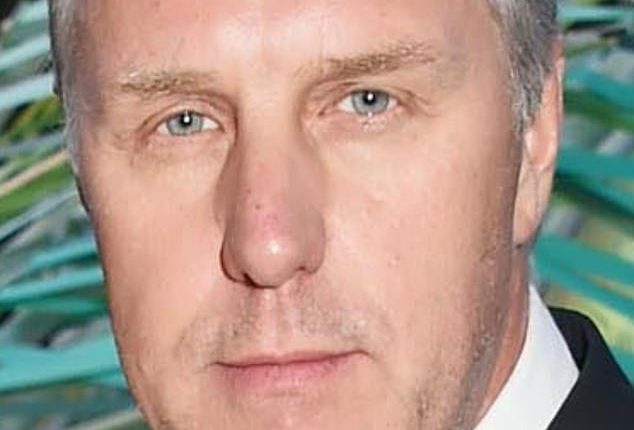It was worst under intense downlight. At restaurants and in over-lit shops, bright and mirrored changing rooms and airport bathrooms.
I had hair, but it was getting candy-floss thin on top and retreating at the crown. Even though I did my best to disguise it, I hated it. In the wrong light, from a distance, my blonde and grey, coarse and occasionally sparse hair made me look old, failing and decrepit.
In close-up, I was sensitive, self-conscious and unconvincing. During more intimate, IRL social encounters and on harshly illuminated, cruelly truth-telling Zoom calls? Blowsy and unattractive. Or, so I thought.
Still, what did I expect? I come from a family of bare heads – my dad and grandfathers, on both sides, all lost their hair in their 30s.
Yes, I was hitting what should have been my tweedy, past-caring mid-fifties – but a Bobby Charlton combover of the kind millions of men used to confect in the 1970s was not an option.
So I looked at the alternatives.

Simon Mills before having his hair transplant, which has made him feel more confident
Most popular, almost ubiquitous in fact, would be to make like action movie hardmen Jason Statham, Vin Diesel et al and ‘own’ my scalp by buzzing all the hair off it.
This is the cheap and modern, macho way to approach male pattern baldness, and men who don’t comply, when faced with their increasingly barren heads, are regarded by those who do as weak, unmanly and untrue to themselves.
A few years back, I experimented with this look and had a death-row number two buzzcut – with disastrous results. What looked great on granite-faced movie stars had a very different effect on a meek, middle-aged civilian. I felt exposed, ugly, vaguely humiliated.
Not rugged or handsome, but infantilised and criminalised – my large, bullet-shaped head making me look more like a Crimewatch mugshot than a big screen bad ass.
So instead of Hollywood, I turned to Harley Street. On a friend’s recommendation I went to Dr Christopher D’Souza (thedsouzaclinic.com), who took some alarming photos of the back of my head (even thinner than when last viewed in the barber’s mirror) and recommended immediate action.
First, a daily 1mg dose of the oral ‘reductase inhibitor’ Finasteride (aka Propecia) which promotes hair growth by decreasing the body’s production of dihydro-testosterone (DHT) by about 70%.(The link between testosterone and hair health is complex, but essentially it’s DHT – a product of testosterone – that’s to blame. Men with both high and low testosterone can lose hair depending on their DHT levels.)

After his hair transplant, Simon Mills saw his portrait in a ‘better, more handsome frame’
You can get Propecia online for around £30 for a two month supply and in theory I’d be taking it for the rest of my life. (Yes, this dad of two would be trading in a few sex hormones for a full head of hair – but it would be worth it.) It worked, too – noticeably healthier, thicker, ‘donor’ hair after six months. Post-operation Finasteride would help my new hair grow faster and stronger too.
After that, a few months later, I am prepped for a new, super-clandestine and almost undetectable method of hair recovery… Yes, a surgical hair transplant.
But why not? I mean, pretty much every other man in the UK and the US, on the TV, the silver screen, in the sporting arena and on Zoom (many of them around my age) seemed to be at it. Ben Affleck, Kevin Costner, Mel Gibson, Sean Penn, Sylvester Stallone, John Travolta, James Nesbitt, Jimmy Carr, Louis Walsh – all have reportedly had hair transplants in the last decade or so.
And every other follicularly-challenged man? Honestly? As long as their hair is not too far gone, they’re either secretly considering a professional mop-op or quietly saving up for one. A good one, mind – not a comically advanced and architecturally straight hairline, like the overly ambitious and distracting, instant pelts favoured by aspirant Love Island boys, probably done during an all-inclusive hair-fare trip to Turkey.
Dr D’Souza, also President of the British Association of Hair Restoration Surgery (BAHRS) and chair of the Oral Examination Committee for the American Board of Hair Restoration Surgery (ABHRS), can spot a good one (and a bad one) a mile off.
‘It’s very subtle, but if you watch seasons of the US version of The Office, for instance, you can see Steve Carell’s hair on its way out in season one, then coming back stronger in season two.’
Those Turkey-originated botch jobs often arrive at D’Souza’s London clinic in desperate need of a fix. He’s repaired teenage hairlines clumsily recreated on 50-year-old men that look like painted-on Action Man tonsures. He’s tended to grafts that have been incorrectly angled, or too densely and deeply distributed, which can disrupt the vascular network supplying oxygen to the scalp and cause actual tissue necrosis. Dr D’Souza shows me some car-crash pictures of men with scarred, blackened heads that look like spent matchsticks.
‘Lots of men seem to think that more grafts will always be better but the aesthetic benefits actually decrease if you use too many.’
Any so-called ‘Black Market’ (i.e. dubiously qualified) service offering to graft 4,000-5,000 follicles should be regarded as suspicious, he says, preferring to work on a maximum of around 2,500 grafts at a time. Also, of course: ‘They might promise 5,000 but, once you are lying down and anaesthetised, how are you going to count?’
Horror stories – including clinics staffed by unlicensed technicians with little to no medical training, performing surgeries without the supervision of qualified doctors – have done little to put off men in search of a bargain barnet.
With Turkey’s hair industry now worth £1.19 billion, the cheap and unnatural Turkey ‘look’ has actually become a trend. ‘Some men actually want that unnatural, straight and angulated hairline,’ says Dr D’Souza. ‘A middle aged man will show me a picture from his 20s and say that he wants that hair back. We refuse do it.’
Dr D’Souza can tell the early adopters too. The hair-maverick Donald Trump is estimated to have had four or five procedures over the years, starting with a ‘punch graft’ hair transplant back in the 1970s, which was as grimly basic as it sounds.
In the 1990s, Trump’s extraordinary ice-cream style benefitted from left and right ‘rotational flap’ operations thinks Dr D’Souza (this being a brutal process where whole sections of amply covered scalp are rotated across the skull to provide cover for balding areas, the donor flap staying attached at one end to maintain blood supply – ewww) and, more recently, a pair of more sophisticated, micro surgical FUE (Follicular Unit Extraction) transplants.
At the recent inauguration Trump was joined in the White House by two more prominent transplantees – Elon Musk and Joe Biden.

Simon Mills with his daughter Laurie Mills before his hair transplant
Dr D’Souza reckons that pretty much all the prominent names mentioned here will have opted for the new and much less noticeable ‘Long Hair’ FUE transplant that involves removing two inch-long, individual follicular clusters (of one to four hairs) from the back of the head, where men’s hair is thicker and bushier, and genetically resistant to DHT, and transplanting them to less fecund areas.
This technique is effective but more fiddly, requires more skill and patience on the part of the surgeon, and takes much longer to show results (sometimes as long as 12 months) but does not require any part of the head to be shaved bald. The older guys – Sly Stallone, Ben Affleck, for example – seem to prefer this option.
‘Sometimes, the best patients for hair surgery are older men with what the industry calls “stable” hair,’ explains Dr D’Souza. ‘If a male patient is, say, in his 50s or 60s, the surgeon will have more to go on and can make a more confident and reasonable prediction about what’s going to happen to his hair in the next few years. A man in his mid-20s desperately seeking the same treatment will find out that this might not be an instant and easy fix, and that there’s likely to be more hair loss in the coming decades, and probably the need for more procedures.’
Increasingly, Dr D’Souza, who honed his micro-surgery skills on an NHS burns and plastics ward, has been seeing even older customers – celebrities and civilians – in their 60s and 70s pass through his theatre. ‘Often I’ll see divorced men who want to start dating again or look younger next to their new wives, who don’t want to look like the old dad at the school gate when they have their second set of kids.’
That’ll be me then. Following my own divorce ten years ago, and being back on the dating market after some 20 years of marriage, the idea of looking better was on my mind and in my mirror. During internet dating, for instance, I was surprised to see some otherwise friendly and eligible women stipulating, baldly, ‘no bald men’ or even ‘must have hair’ in their list of requirements.
At work, surrounded by a team of men and women in their 20s and 30s, I wanted to present as relevant, competent and sharp.
The surgeon agrees. ‘Men are also staying in work for longer. They want to look their best and feel confident and relevant around their ever–younger work colleagues.’
The lockdown months of 2020 proved a boom for the hair replacement business, he adds. Unlike orally-intense dentists and close contact hairdressers, transplant clinics were granted medical status by the British government and could carry on taking appointments.
‘During lockdown men were working from home, constantly on Zoom calls and taking part in video conference links and feeling this pressure to be presentable and photogenic.’
Forced to have a good look at themselves on camera pretty much every day, a lot of them decided that they didn’t want to be old.
Despite the rapid de-stigmatisation of hair surgery – and its truly remarkable success rate of 97-100% for UK clinics – men still have concerns; about pain, humiliation, unwanted attention, plus the amount of time they are going to have to take off work. And the price tag.
A Harley Street operation will typically cost between £4,000 –10,000. Fly to Turkey and the price – including airfare and hotels – drops to £2,000 – £3,500. Why pay more?
A Turkish procedure will likely entail some video consultations over the internet, instead of a thorough, personal and face-to-face consultation. You’ll also probably only get to meet the surgeon on the actual day of the surgery. ‘This is never a good idea,’ says Dr D’Souza. ‘Because once you’re there, you are committed and, with many clinics working on five or six patients at a time, discussions over crucial stuff like hairline design will be brief.’ D’Souza personally conducts just three procedures a week, a maximum of one a day.
The biggest scam, he says, is inappropriate and irresponsible ‘delegation’ during the highly skilled incision and excision process.
In the UK, the General Medical Council stipulates that a qualified surgeon’s hand must do this. But: ‘In the black market clinics there might be no surgeons at all, or a single roving surgeon meeting each patient then delegating the actual work to unqualified technicians who might over harvest, leaving donor areas patchy and depleted, thin and sort of… moth eaten.’
More gruesome pictures (from the International Society of Hair Restoration Surgery’s Fight the Flight website) and my head is put off Turkey forever.
My own op? In grey and cloudy but responsible and properly qualified Great Britain, it was a breeze. I arrived at Harley Street in the morning, and lay face up (and then face down) on a bed, as if at the masseur’s. My skull was completely numbed with anaesthetic, the rest of me wide awake enough to watch Netflix.
Using a state-of-the-art, oscillating WAW punch, invented by Belgian surgeon Dr Jean Devroye (former recipient of the industry’s prestigious Platinum Follicle Award) multiple, apple core-like shafts of two or three hairs – traces of middermis level tissue around them – were extracted from the healthy, donor areas at the back and sides of my head.
The WAW machine’s trumpet-shaped tip, just 0.91mm wide, with a 90 degree cutting angle, delivered a small and weird crunchy sensation as each clump was pulled. But virtually no pain.
These precious grafts were then sorted out into specific categories, submerged in an active plasma solution and refrigerated in petri dishes. Following lunch, Deliveroo’ed to my horizontal positon, these same grafts were meticulously relocated to the bare patches. My hair do was all done by 5pm and after a thorough clean up and the slightly undignified attachment of a dinner lady-like, clear plastic cap on my head, I caught a cab home.
For the first few nights, I had to avoid the shower and sleep carefully, not disturbing the new and delicate grafts with any abrasive pillow contact. Or bang my still-numbed skull on any door frames. Apart from that, I looked and felt no different. No one else, sometimes not even me, noticed any difference.
Then, a long wait.
For weeks and weeks nothing much happened. But… after six months, the semblance of a fuzzy feeling when I rubbed bits of my head. Was it working?
Each week seemed to deliver thicker hair and improved coverage. It was beyond thrilling. When I went for a haircut, my regular crimper was genuinely astonished. ‘It’s a miracle!’ she said. I rewarded myself with a long and close look in the mirror. My first for about 15 years.
What did I see looking back at me? Not so much younger man but an subtly improved version of my old self. A portrait in a better, more handsome frame.
The texture and colour, front to back, matched up and everything seemed to flow, hang and sit in a natural, un-Trumpian way. It was really hard to tell new hair from old. I felt more confident about swimming and flirting. Ready to walk under overhead lights. Then, after a while – and this really is the best, most triumphant and satisfying bit of the whole process – I started to forget about it all together.
Until, eight months or so after my procedure, I went to a party and bumped into an American friend of a similar age – and level of vanity. At my arrival he greeted me with a subtle double-take and later, beneath overhead lighting, cornered me and pumped me for information.
‘Your hair looks great,’ he said. ‘You b*****d.’
This is how men compliment one another.
And then, checking first to see that no one else was listening: ‘You have to give me your surgeon’s number.’







